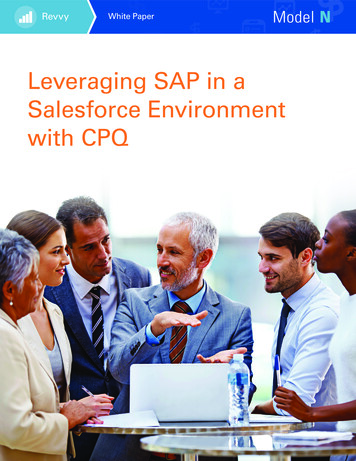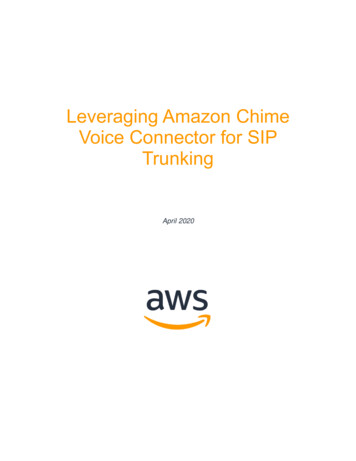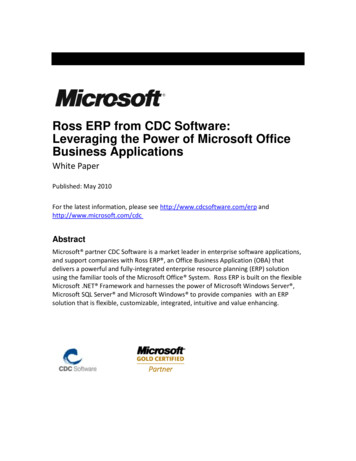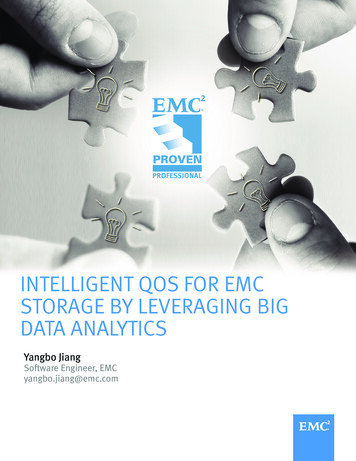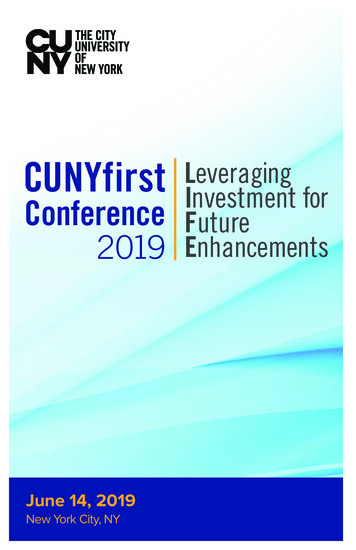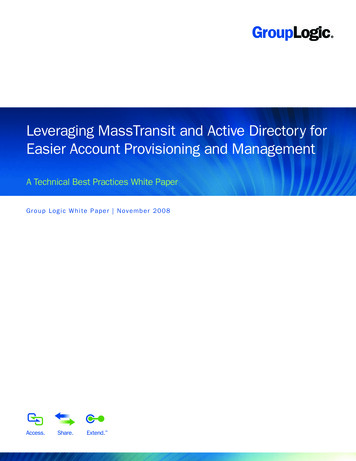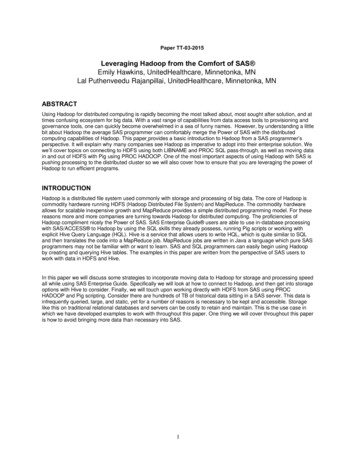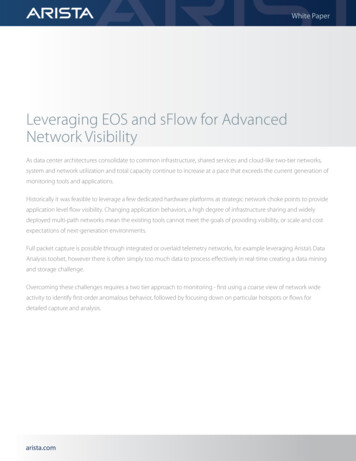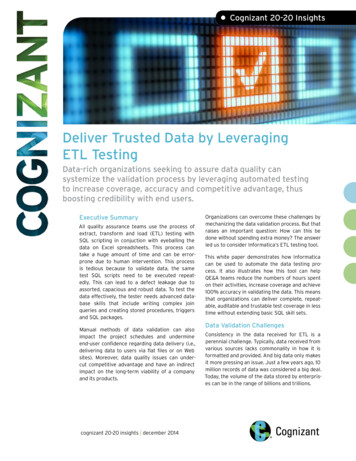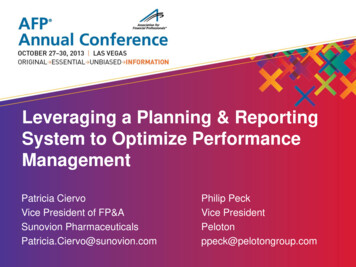
Transcription
Leveraging a Planning & ReportingSystem to Optimize PerformanceManagementPatricia CiervoVice President of FP&ASunovion PharmaceuticalsPatricia.Ciervo@sunovion.comPhilip PeckVice PresidentPelotonppeck@pelotongroup.com
Agenda Introductions Background Solution Optimization: System Upgrade and FP&AProcess Improvement Keys To Success The Continuous EPM and BI Journey Q&A
Sunovion OverviewSunovion is a leading pharmaceutical company dedicated to discovering, developing, and bringing to market therapeuticproducts that advance the science and medicine to improve the lives of patients, their families, and communities. Wespecialize in treatments that help people challenged by disorders of the central nervous system and respiratory ailments.Our current pipeline spans a number of indications / targetsCandidateIndication / TargetPhaseLurasidoneMaintenance treatment, Schizophrenia andBipolar DisorderPhase IIIEslicarbazepineacetateEpilepsy – AdjunctNDASubmittedEslicarbazepineacetateEpilepsy – Adult MonotherapyPhase IIISEP-289Attention-deficit hyperactivity disorder (ADHD)Phase IISUN-101COPDPhase IIDSP-1053Major Depressive Disorder (MDD)Phase IDSP-2230Neuropathic PainPhase ISEP-856SchizophreniaPhase IWT2725Hematologic and Solid CancerPhase I
Peloton OverviewPELOTON is a professional services firm, founded with the sole purpose of assisting our clients seize the promiseof Analytics. At the core of who we are, we believe that Analytics delivers strategic advantage, and thosecompanies acting on the best information will be the market leaders of tomorrow.We develop long-term relationships with and deliver tangible results for our clients through: Our 60 professionals with proven track records from the top firms in our industryA unique combination of process improvement consulting and hands-on technical implementation expertiseCollaborative implementation methodologies that drive end-user adoptionLife SciencesSolutions for . . . Finance Operations Information Tech Sales & Mktg.Oil & GasHealthcareAerospace & DefenseFinancial ServicesRetailManufacturingNot-for-Profit. . . Services for Business Intelligence Performance Mgmt. Data Integration Solution Adoption Software Installations
Agenda Introductions Background Solution Optimization: System Upgrade and FP&AProcess Improvement Keys To Success The Continuous EPM and BI Journey Q&A
EPM Landscape – Early 2011In early 2011, Sunovion and Peloton partnered together to embark upon a Hyperion Planning Upgrade.At that time, the Sunovion Performance Management Landscape was: 1 Hyperion Planning Application (with WorkforcePlanning enabled)3 EIS Cubes for Web Analysis DashboardsA fully integrated financial data warehouseHyperion Application Link (HAL) for Metadata and DataIntegrationsMS Access to manage hierarchies and keep theapplication hierarchies in syncEarly 2011 Architecture Diagram Combination of both SmartView and the Excel Add-in to provide ad-hoc analysis and reportingDifficulty keeping the Development and Production instances in sync due to the effort required formigrationsKnown opportunities to improve the usage of the existing EPM environment including input forms, reports,ad hoc analysis, etc.
Overall Business ChallengesProduct Portfolio Transition from single product to multiple product portfolio and loss of exclusivity on core product(s)Significant increase in the number of programs, projects, and trials that need to be actively planned, managed,reported against, and analyzedSubstantially greater breadth and complexity impacted systems and tools, planning and reporting needs, andaccountability for business performanceParent Company Requirements Increased demand for plan and forecast detail and comprehensive variance analysisFocus on rolling, extended view of business performance with longer time horizons vs. annual calendarIntensified focus and scrutiny around business plans and performanceGlobal view of business performance with evolving guidelines and demandsRegulatory Environment More regulations (e.g. Sunshine Act, E-Pedigree / Serialization)Greater demands on FP&A for data, information, and analysisInternal and external business dynamics generated increasing demands on the FP&A organizationand the methods, processes, tools, and systems used to support performance management
FP&A Specific Challenges Efficiency andEffectiveness Tools, Systems,and EnablingTechnology Manual effort, off-line Excel models, and significant data manipulationrequired to support key planning and reporting processesSignificant time and effort required to collect, validate, transform, andformat data and information needed for planning and reportingFP&A spending inordinate time on data collection and manipulation at theexpense of providing business insight and analysisPockets of best demonstrated practices not fully institutionalizedConfiguration of the EPM applications had not been substantively updatedsince the original implementation 7 years agoOpportunity to rethink and improve upon design decisions includingexpense plan level of detail, driver-based models, and report standardsSub-optimal system performance for input form refreshes, businesscalculations, and system aggregationsLimited ability to accommodate “real-time” changes in plan cyclesIncreased demands on the Financial Systems Support Team
Defining a Path ForwardLet’s now look at the key enablers to Sunovion's Solution OptimizationInitiative and their overall business transformation journey
Key Enablers of the Transformation Desire and Case for Change Strategic FP&A Vision and Leadership Information Architecture and Enabling Technology Foundation Independent Perspective Mobilization Framework
Desire and Case for ChangeDemands on FP&A Proactively manage the changes delivered from the parent companyProvide more value added insights and analysisReduce planning and reporting cycle timesDrive greater ownership and accountability throughout the organizationKeep pace with an increasingly complex and challenging business environmentBusiness ProcessImprovementOpportunities Standardize report formats and automate creation of management reportsReduce level of effort required for annual planning and periodic forecastingRationalize the level of planning detail and focus on key business driversSystematize key planning and reporting models and reduce dependence ondisconnected off-line Excel modelsEPM Evolution –New Features &Capabilities Optimize system performanceImprove access to data and informationLeverage new functionality aligned with redesigned business processesReduce level of effort required for administration, maintenance, and support ofEPM environment
Strategic FP&A Vision & LeadershipFP&A Vision Become the indispensable business partnerDefine business needs, improves business processes, and optimally deploy enabling technologyContinuous improvement driving FP&A and company wide efficiency and effectivenessCollaborative environment where FP&A fosters sharing of best practices across organizationDistributed ownership and accountability for business performanceLeadership Credibility within the organizationForesight ability to anticipate changes on the horizonEstablishing momentum and pushing the ball forwardQuarterback using an explicit game plan but adapting on the fly as dynamics changeNegotiation skills“Pick and choose your battles” (opportunities)
Enabling Technology Foundation Previous StrategicInvestmentsAdherence toReferenceInformationArchitectureFinancial SystemsTeam Robust and extensible Financial Data Warehouse integrated with core OracleERP applicationsAutomated ETL processes throughout end-to-end information architectureCore financial planning and workforce planning application Components: Sources – Data Integration – Analytic Models – PresentationFoundational platform accommodating new models, applications, andcapabilities without rework and unnecessary investments Deep business and technical expertise“Can-do” attitudeTrue partners with business functions, FP&A, and ITShared vision with FP&A leadership regarding optimal usage of technology
Independent Perspective Deep business process and technology implementation expertise Significant experience orchestrating solution optimization projects– Future state envisioning– Business process and technology deployment best practices,– Facilitating requirements workshops– Roadmap development Trusted advisor Industry specific knowledge and expertise Prior experience working with Sunovion
Mobilization FrameworkA proven approach for evaluating where an organization is today, determining the desired end-state planningand performance management capabilities, identifying and prioritizing initiatives, and defining path forward.BASELINEDiscovery and current landscape,determine key business needs, anddocument issues and improvementopportunities.Assessment &Key InitiativesSynthesize findings, envision thefuture state, articulate the current tofuture gap, identify quick hits, anddefine initiatives.PRIORITIZE & PLANRoadmap &Implementation PlanPrioritize initiatives to achieve thefuture state, create an actionableplan to get there, and determine thePhase 1 projects.
Decision PointWith a well articulated catalyst for change, strong FP&A leadership, and a robustinformation architecture foundation in place, Sunovion was ready to embark on theirperformance management transformation journey. The initiative would address businessprocess elements as well as the technical systems and applications upgrade.Sunovion then partnered with Peloton who provided best practice based process and technologyimplementation expertise and their Mobilization framework to assist with successfully executingthe solution optimization initiative.
Agenda Introductions Background Solution Optimization: System Upgrade and FP&AProcess Improvement Keys To Success The Continuous EPM and BI Journey Q&A
Project Goals and ObjectivesGoalImprove and enhance the planning and reporting capabilities of Sunovion by upgrading to the most currentversion of the Oracle-Hyperion EPM solution. Identify business process improvement and technology changesthat address immediate business needs, anticipate future business requirements, and optimize the overallsolution environment.DeliverablesObjectives Establish the HW and SW Environment Performance Management Assessment & Mobilization EPM Solution Upgrade Scope and Definition Systematic Hierarchy and Master Data ManagementWorkforce Planning – Rationalize and EnhanceEnable Multi-Currency CapabilityLifecycle ManagementCOA Segment Changes – Planning Arch Updates Functional and Technical Gap AnalysisProcess and Technical Solution DefinitionRefined Scope - Updated Implementation PlanBusiness Process Improvement ListPerformance Management Roadmap“Quick Wins” Requirements and Design DocumentsTechnical Solution and System DocumentTest Approach and PlanMigration Plan
Discovery Workshops – Key LearningsExisting system constraints and non-optimized configuration resultin long system refresh, calculation, and aggregation times.Manually intensive and timeconsuming, data access and formattingissues, non-standard planning process.SystemPerformance& UsabilityCapitalPlanning andSpendingHistorical data resides inmultiple sources requiringmultiple data retrieves, datatransformation, formatting,and reconciliation.BusinessViewsPain PointsFull ProductLife CycleAnalysisOff-line Excel allocation calculations. Limitedvisibility to logic and assumptions. Reportcreation requires manual effort for datacollection, formatting, and consolidation.Product P&LReportingand AnalysisProductCostingPlanning eral key business views notsystematically available (e.g.Therapeutic Area). Manual effort tocollect, manipulate, and “create” alternateviews.Revenue is planned, reported, andanalyzed by various constituents usingdata and information from multiple,disconnected, local spreadsheets.Requires manual effort, additionalwork steps, and data manipulation.Excessive manual effort and work stepsrequired to execute the end-to-end process.Limited ability to complete deep-diveanalysis as detailed allocations occurring inExcel generate summary data for planning.
Performance Management (EPM) Maturity ModelStage 1“Build the Foundation”Improved efficiency andeffectiveness in reportingactual results and coreplanning models Centralized data warehouseStage 2“Expand the Core”Expanded scope of actualresults reporting withexpanded and improvedintegration of modeling andplanning capabilitiesStage 3“Leverage and Optimize”Complete fully integratedPerformance Managementplatform which enablescomprehensive modeling,“what-if” analysis, and businessanalytic capabilities. Expand data subject areas populatingthe common data warehouse Continue expanding subject areaspopulating the data warehouse Enhance / extend reporting capabilities Exception-based reporting and analysis Analytic reporting cube accessedthrough robust reporting tools Build additional planning models in theenterprise application Robust “what-if” analysis, scenarioplanning, predictive analytics Enterprise planning application withmodel for Financial Planning & Analysis(FP&A) Improve integration betweenPerformance Management and relatedoperational applications Seamless integration betweenoperational applications Standard management reporting Expand master data mgmt. capabilities Basic master data management Introduce Exec Dashboards Automatic data loading from multiplesource systems Enterprise master data management Integrated strategic and operationaldashboards for Execs / Mgr’s / Analysts
Original EPM Roadmap2011Q32012 & BeyondQ4Full YearPerformance Management (Hyperion)System 11.xUpgradeEssbaseOptimizationProduct CostingAllocations & RptingProduct P&LCapitalSpending & TrackingRevenueReportingFiscal Calendar ChangeMulti-Currency EnablementLong Range PlanExtend BusinessCapabilitiesPhase 1CapitalPlanning ProcessPhase 2Establish a Performance Management Center of Excellence (COE)Reporting, Analytics & FoundationHyperion Financial Management (HFM)Oracle Business Intelligence (OBI): Transactional Reporting (Discoverer) & BI ReportingOracle E-Business: Release 12 UpgradeRoutine HyperionMaintenanceFuture Phases
Several “Quick Wins” were part ofthe Solution Optimization initiativeTechnology Enablement Essbase Optimization: Reviewed existing settings and properties and identified changes that significantlyimproved application performance for the forecast cycle before the upgradeHistory Cube: Created separate location for storing all revenue and expense data related to projects. Thishistorical cube accommodated full lifecycle historical reporting and analysis as necessary and allowed forstreamlining of the core Planning applicationInformation Architecture / Master Data Management EPMA: Given efficiency and automation opportunities and the know desire to add EPM and BI applicationsin the future, implemented EPMA to systematically manage hierarchies and relates master and meta data.Process Improvement Streamlined Planning Process: Existing usage of application functionality “Supporting Detail” providedlimited value very little value given level of effort required. Eliminated usage of functionality and providedalternative, more efficient methods for achieving similar goals.
Business BenefitsSystem Environment Reduced planning and reportingcycle time Improved access to information Flexibility Automation Consistency and standardization Foundational building blocksanticipating longer-term needsand end-state vision Initial business processimprovementsRoadmap Future state FP&A vision Intentional path forward Prioritization of potentialinitiatives Collaboration and organizationalengagement Alignment and consensus
Agenda Introductions Background Solution Optimization: System Upgrade and FP&AProcess Improvement Keys To Success The Continuous EPM and BI Journey Q&A
Exploring the “Art of the Possible”Planning Process More granular detail is not necessarily better. Focus on business drivers and materiality.Ensure integration between functional areas and consistent definitions and usageReporting and Analysis Common analytic views of the organization and standardize the core management reportsAutomate report generation and provide self-service capabilityRationalize report universe and eliminate unnecessary one-offsEnabling Tools and Technology Learn from prior initiativesLeverage existing EPM architecture and platformIterative prototypes with heavy end user interaction and knowledge transferPerformance Management Roadmap and Phased implementations Identify and prioritize improvement opportunities using a transparent, logical frameworkFrame initiatives in the context of the larger performance management end-state visionSocialize, incorporate feedback, and internally sell the roadmap to build support and momentum
Stakeholder Alignment Establish clear goals well understood by business, IT, and the implementation team Leverage regular iterative cycles to design, develop, build, test, and deploy the solution Engage and interact with the business end users as often as possible Manage expectations
Lessons LearnedCross-Functional Participation Essential to engage key business SME’s across finance, business, and ITNot everyone fully embraces the initiative nor understands the end-state visionQuick Wins Deliver business value quickly and demonstrate successCreates desire for greater participation (“what about me ”)Change Management Breaking with the past can be very difficultNavigating the internal dynamics and politics requires an intentional plan and constant effortThere will always be bumps in the road Anticipate and develop contingency plans for unexpected events and delaysManage expectations across all constituents (“Rome was not built in one day”)
Agenda Introductions Background Solution Optimization: System Upgrade and FP&AProcess Improvement Keys To Success The Continuous EPM and BI Journey Q&A
Sunovion Progress - EPM RoadmapPlanning & Reporting MobilizationProduct P&L POCProduct P&LFiscal CalendarMay 2011Nov 2011 – Jan 2012Jul 2012 – Nov 2012Mar 2013 – Apr 2013Developed a strategic roadmap and approach tosupport the Finance organization to improve theinternal performance management capabilitiesCreated foundation forthe Product P&L ModelProductionalized theProduct P&L ModelModify the Planning solutions tochange the calendar to align to theneeds of the business2011HyperionPlanning UpgradeMay – Sep 2011Upgraded the previoussystem in place andenhanced the linkagesbetween systems andprocesses2012Essbase OptimizationProduct CostingJune 2011Feb 2012 – Oct 2012Developed alternate hierarchiesto enable more robust reportingProduced an analytic engine and input templatesto build the Standard Cost across all product linesRevenue Reporting and AnalysisMulti-CurrencyFeb 2012 – Oct 2012Feb 2013 – Apr 2013Created common repository for Revenueinformation intended to reduce themanual effortEnable local input for budgeting and forecastingpurposes, created calculation logic required toreport in additional currencies in the future2013Resource PlanningPilotApr 2013 – Jul 2013Produced a pilotapplication showcasingthe ability to use HyperionPlanning to forecastresources across R&D
Expanding and Enhancing the Information Architecture
What is next on the horizon ?Enabling Technology and Business Adoption Applications are engrained with the users “Can’t live without Essbase”Environment provides essential tools and capabilities critical for driving business forwardSeparate initiative to enhance overall solution support and continuous improvementEnhanced Analytics an
Information Tech . Reference Information Architecture Financial Systems Team . Essbase Optimization: Reviewed existing settings and properties and identified changes that significantly improved applicat
